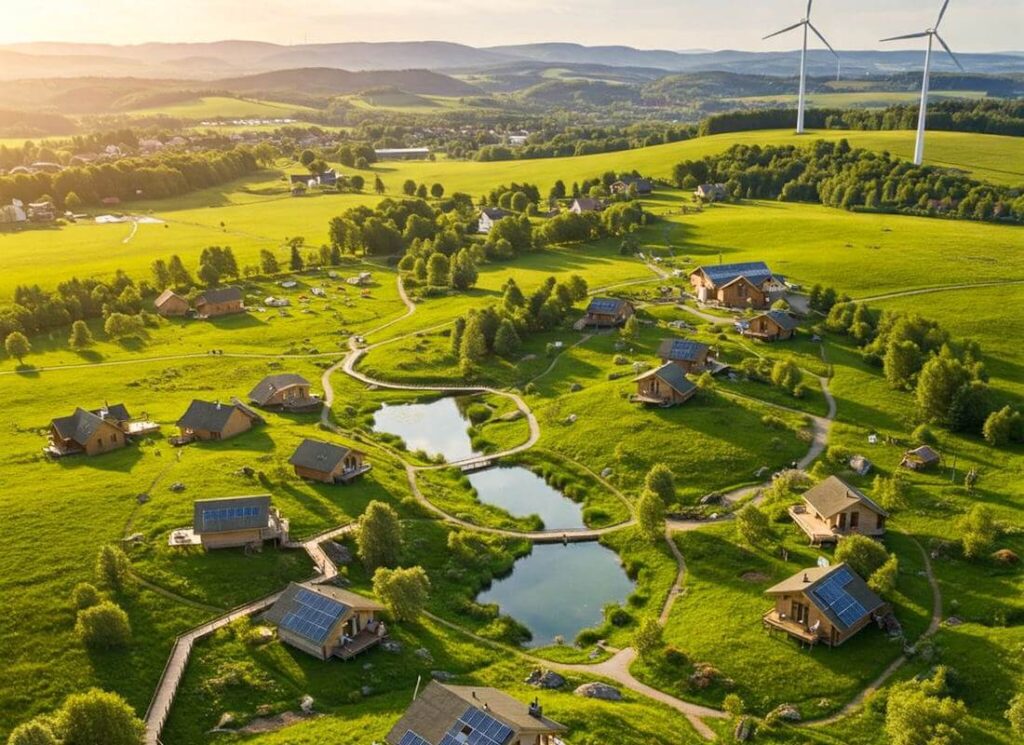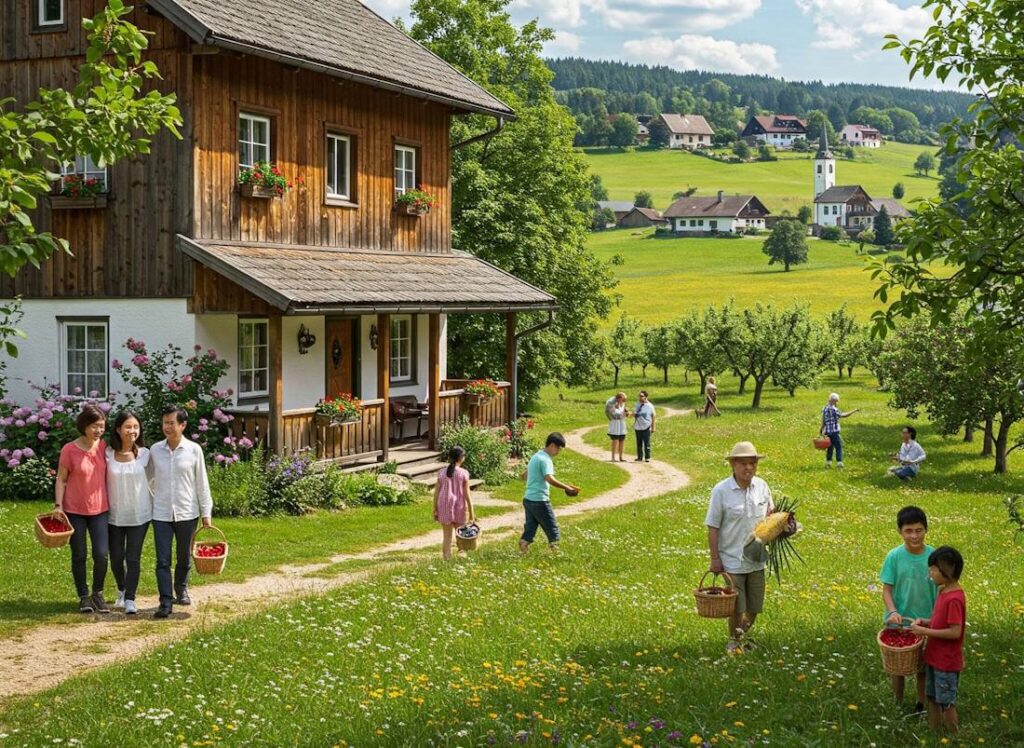Introduction: The Potential of Rural Tourism
Rural tourism has emerged as a prominent trend in the travel industry, reflecting a growing interest in escapes that provide authentic experiences away from urban centers. This sector encompasses various activities, including farm stays, eco-tourism, and cultural experiences that immerse visitors in the natural beauty and unique heritage of rural areas. The evolution of rural tourism is not merely a fleeting trend; rather, it is a response to the increasing desire for a more immersive and enriching travel experience.
One of the notable advantages of rural properties as tourism destinations is their ability to attract diverse demographics. Visitors often seek respite from the hustle and bustle of city life, which rural environments can uniquely provide. Families, couples, and solo travelers alike are drawn to the tranquility, picturesque landscapes, and the opportunity to engage in outdoor activities that rural locations facilitate. Furthermore, the privacy and spaciousness afforded by rural properties can cater to various visitor preferences, enhancing their overall experience.
Moreover, rural tourism plays a significant role in promoting local culture and traditions. By showcasing authentic experiences such as artisanal crafts, regional cuisines, and community events, rural destinations can create a rich tapestry of experiences that not only fascinate but also educate visitors. This exposure helps bolster cultural pride amongst residents and encourages sustainable tourism practices that benefit the local community. The influx of tourists can stimulate the local economy, providing a vital source of revenue for farmers and local businesses.
In summary, the potential of rural tourism extends far beyond economic benefits; it serves as a platform for cultural exchange, community engagement, and a deepened appreciation of nature. As interest continues to rise in these unique travel experiences, embracing rural land for tourism presents an opportunity for landowners to contribute positively to their communities while showcasing the enchanting beauty of rural life.
Understanding Your Land: Assessing Potential
Evaluating the potential of your rural property involves a comprehensive assessment of several key attributes. First, consider the landscape. The natural terrain, vegetation, and overall aesthetics play a significant role in determining the appeal of your land to tourists. Properties with stunning views, unique geographical features, or diverse ecosystems can serve as major attractions. Potential customers may be drawn to hiking, wildlife watching, or simply the tranquility that rural environments provide.
The location of your property is another critical factor. Proximity to urban centers, accessibility via major roads, and the presence of nearby attractions can significantly enhance the viability of your tourism destination. Consider mapping out routes to nearby parks, cultural heritage sites, or other amenities that may entice visitors to your area. This will allow you to strategically promote your property as part of a larger tourism experience.
Existing structures on your property should also be thoroughly examined. Evaluate whether there are buildings that can be renovated or repurposed for tourist lodging, gatherings, or events. Depending on the condition and style of these structures, they could offer a unique charm that sets your property apart from conventional hotels or lodges.
Additionally, it is imperative to conduct a detailed analysis of your natural resources, such as water sources, forests, and wildlife. Sustainable tourism models often leverage these assets while ensuring environmental preservation. Understanding the local climate and seasonal variations can aid in planning activities that align with the best times to attract visitors.
Moreover, adhering to zoning laws and local regulations is vital for development. Familiarize yourself with the legal framework that governs land use in your area before making any significant changes. Compliance ensures that your plans align with community standards and environmental considerations, ultimately maximizing the potential of your land for tourism purposes.
Identifying Your Target Market
Understanding your target market is a pivotal step in transforming rural land into a viable tourism destination. By identifying and segmenting potential visitors, you can tailor your offerings to meet the diverse needs and interests of various groups, enhancing their overall experience. For rural tourism, the primary target markets often include families seeking educational experiences, adventure seekers looking for outdoor activities, and cultural enthusiasts interested in local history and traditions.
Families may be interested in activities that promote bonding and learning, such as farm tours, workshops on sustainable practices, and interactive wildlife experiences. To attract this demographic, offering family packages that combine accommodation with engaging activities can be highly effective. Additionally, providing amenities that cater to children, such as playgrounds or petting zoos, adds significant appeal for parents looking to create lasting memories with their children.
On the other hand, adventure seekers are typically drawn to outdoor experiences that challenge their physical limits. This can include hiking, biking, fishing, or even wildlife safaris. To attract this segment, it is essential to highlight the unique natural features of your property, such as hiking trails, lakes, or scenic viewpoints. Collaborating with local outdoor adventure companies to offer guided tours or equipment rentals can also enhance the experience and draw in this audience.
Cultural enthusiasts represent another significant market segment. They are often attracted to the stories, traditions, and heritage of the region. Providing workshops, farm-to-table dining experiences, and local artisans’ showcases can create a rich cultural experience that resonates with this audience. It is also beneficial to emphasize collaboration with local cultural institutions or events that reflect the character of your area.
In summary, identifying and understanding your target market is crucial for developing tailored marketing strategies and offerings for your rural tourism destination. By engaging with families, adventure seekers, and cultural enthusiasts, you can effectively enhance their experiences and drive interest in your property.
Unique Offerings: Activities and Experiences to Consider
Transforming rural land into a tourism destination necessitates the innovative creation of unique activities and experiences that resonate with visitors. Emphasizing the distinctive features of your property can engage guests in memorable ways, motivating them to explore and appreciate the rural landscape.
One appealing option is to offer farming experiences. This may involve guided tours of the farm, allowing visitors to participate in activities such as planting and harvesting crops, feeding livestock, or learning about sustainable agriculture practices. Such hands-on experiences not only educate visitors but also foster a connection to the land, making their stay more meaningful.
Outdoor adventures are another enticing prospect for rural tourism. Depending on the landscape, activities might include hiking, biking, fishing, or birdwatching. Partnering with local outdoor adventure companies to provide guided tours can highlight the natural splendor of your property while ensuring visitor safety and enjoyment. Creating designated trails or scenic viewpoints can encourage exploration and appreciation of the surrounding environment.
Craft workshops present another engaging opportunity by showcasing the local arts and crafts scene. Organizing sessions where visitors can learn traditional skills such as pottery, basket weaving, or painting can highlight local artisans and provide unique souvenirs for participants. This not only supports local craftsmanship but also allows guests to closely engage with the cultural heritage of the area.
Culinary tours can serve to enrich a visitor’s experience as well. Offering farm-to-table dining experiences, cooking classes using local ingredients, or wine and cheese tastings can showcase the rich flavors of the region. Collaborating with local chefs to create unique menus can enhance the appeal of your offerings and encourage guests to return for future culinary adventures.
By thoughtfully integrating these diverse activities and experiences, rural property owners can create a rich tapestry of unique offerings that attract visitors and amplify the appeal of their tourism destination.
Developing Infrastructure and Amenities
To transform a rural property into a thriving tourism destination, the development of appropriate infrastructure and amenities is crucial. Accommodation options are varied and can significantly enhance the appeal of a property. Potential visitors often seek diverse experiences, therefore offering options such as comfortable cabins, campsites, or luxury glamping tents can cater to a wide range of preferences and budgets. Each accommodation type should be constructed with both comfort and the natural environment in mind to ensure an inviting atmosphere that complements the rural charm.
In addition to lodging, essential facilities must be in place to support guest needs. Clean and accessible restroom facilities are a necessity, as are adequate parking areas to accommodate vehicles of different sizes. Dining areas or kitchens can also add significant value to the guest experience. For instance, creating a communal space where tourists can enjoy meals together fosters interaction and enhances their overall stay. If possible, incorporating local cuisine into the dining options will not only appeal to visitors but also promote local culture and agriculture.
Accessibility can present challenges when developing infrastructure on rural land. It is important to consider how easy it is for guests to reach your destination. Paved roads or well-cleared paths leading to accommodations can enhance accessibility, particularly for individuals with mobility impairments. Additionally, providing clear signage and information about activities available on the property will ensure that guests feel welcomed and informed. It is also essential to strike a balance between modern amenities and the natural beauty that makes rural destinations special. By developing thoughtful infrastructure and amenities, property owners can create a memorable experience for visitors and establish a successful tourism venture in rural locations.
Marketing Your Rural Destination
Marketing a rural destination involves a multifaceted approach, blending traditional strategies with modern digital tools. The first step in attracting visitors to your property is to build a robust online presence. A professional website serves as the foundation for displaying the unique attractions of your rural area. It should feature high-quality images, detailed descriptions of available accommodations and activities, as well as up-to-date information regarding booking procedures. Implementing search engine optimization (SEO) strategies can further enhance visibility, ensuring that your destination appears prominently in search results.
Social media channels are indispensable for promoting a rural tourism destination. Platforms like Instagram and Facebook enable you to share captivating visuals and engage directly with your audience. Creating informative and entertaining content, such as posts highlighting local flora and fauna, culinary offerings, or upcoming events, can pique interest. Regular updates and interactions with followers foster a sense of community, encouraging users to share their experiences and tag your property in their posts, thereby increasing exposure.
Networking with local tourism boards and organizations can also amplify your marketing efforts. Collaboration with regional entities fosters credibility and allows you to tap into established visitor channels. Participating in local tourism fairs and expos can create valuable opportunities to showcase your property to a broader audience. Additionally, aligning with influencers who focus on travel and experiences can provide a significant boost. Inviting them to experience your destination and share their insights with their followers can lead to organic promotion and attract new visitors.
Lastly, crafting compelling narratives around your rural destination is crucial. Storytelling can evoke emotions and create a connection with potential guests, inviting them to embark on a personal journey. Highlighting local culture, heritage, and personal anecdotes cultivates a unique selling proposition that sets your property apart in an increasingly competitive market.
Building Partnerships and Collaborations
Creating a successful tourism destination on rural land often relies on the strength of partnerships and collaborations with local businesses and organizations. Forming alliances can significantly enhance the visitor experience while contributing to the local economy. Well-coordinated collaborations can offer unique package deals that encourage tourists to explore various attractions and services within the area.
For example, a rural property owner can partner with local cafes and restaurants to create meal inclusion packages for tourists, allowing them to experience local cuisine alongside the natural beauty of their surroundings. Co-hosted events, such as farm tours or seasonal festivals, can draw larger crowds and provide a platform for local artisans and businesses to showcase their offerings. Such events not only elevate the profile of the rural property but also bolster the economic stability of the entire region.
Joint marketing efforts represent another crucial aspect of effective collaboration. By sharing resources and promoting each other through social media, websites, and local tourism brochures, rural landowners and neighboring businesses can reach a broader audience. Utilizing distinct yet complementary branding can create a cohesive message that piques the interest of potential tourists seeking an authentic experience. Moreover, collaborations can lead to greater visibility during peak tourist seasons, ensuring that visitors consider the local offerings.
Furthermore, forming alliances with local organizations, such as tourism boards or conservation groups, can provide valuable insights and support. These organizations often have established networks, promotional resources, and marketing expertise that can benefit all partners involved. Through fostering collaborative relationships, rural landowners can achieve a win-win scenario where they benefit from increased visitors while supporting the vitality and sustainability of their local communities.
Understanding Seasonal Trends and Planning Activities
Rural tourism can be significantly influenced by seasonal trends, impacting both visitor interest and the range of activities that proprietors can offer. Recognizing these trends is vital for effectively transforming a rural property into a thriving tourism destination. Each season brings distinct opportunities; for instance, spring may attract visitors interested in flower festivals or nature walks, while summer could draw those seeking outdoor activities like hiking, camping, or fishing. In contrast, fall often invites guests looking for autumn foliage and harvest-related experiences, such as apple or pumpkin picking. Winter presents a chance to attract tourists interested in snow sports or seasonal festivities.
To maximize the potential of rural land throughout the year, property owners should develop a comprehensive annual calendar of events and activities that align with these seasonal interests. This strategic planning allows for the diversification of offerings, ensuring that visitors have a reason to return regardless of the season. For example, one could host seasonal markets, guided tours, or workshops tailored to local produce and crafts, thus enhancing the rural tourism experience.
Moreover, it is essential to remain cognizant of weather patterns when planning these activities. Developing contingency plans for unforeseen weather situations can keep visitors engaged and satisfied, regardless of potential disruptions. This may include offering indoor activities during inclement weather or adjusting schedules to accommodate fluctuations in seasonal demand. By thoughtfully considering both seasonal trends and weather conditions, you can create a flexible, appealing itinerary for visitors. This proactive approach not only encourages repeat visits but also fosters a vibrant local tourism economy, making your rural property a desirable destination all year round.
Sustainability Practices in Rural Tourism
In order to successfully develop a tourism destination in rural settings, it is imperative to adopt sustainability practices that minimize environmental impact, support local communities, and promote conservation efforts. Sustainable tourism is not merely a trend; it is a necessary approach that engages and educates both visitors and hosts, ensuring that rural areas can thrive economically while preserving their natural beauty for future generations.
One of the primary methods for minimizing environmental impact is the use of eco-friendly accommodation options. Property owners can consider constructing lodgings using sustainable materials, implementing energy-efficient systems, and utilizing renewable energy sources such as solar or wind power. Additionally, effective waste management practices, including recycling and composting, should be prioritized to reduce the carbon footprint associated with tourism activities.
Supporting local communities is another fundamental aspect of sustainability. This can be achieved by sourcing food and materials from local suppliers, which not only helps the local economy but also fosters a sense of community engagement. Offering local experiences, such as guided tours led by residents or workshops that showcase regional craftsmanship, enhances the tourist experience while ensuring that the benefits of tourism are shared among local stakeholders.
Promoting conservation efforts is equally crucial in rural tourism. Property owners can organize initiatives such as tree planting, wildlife conservation programs, or habitat restoration projects, which engage visitors in meaningful activities that contribute to the protection of the environment. Additionally, informative signage and educational programs can raise awareness about the local ecosystem and biodiversity, encouraging travelers to appreciate and protect the natural surroundings.
Incorporating these sustainability practices into a tourism business model is essential for appealing to environmentally conscious travelers. By prioritizing eco-friendly approaches, rural properties can create a meaningful impact on both the environment and the local community.



